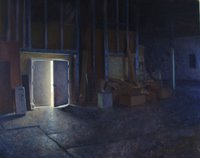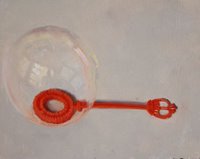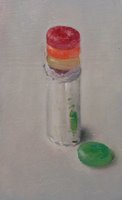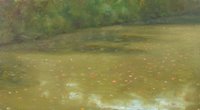
Thursday, May 18, 2006
Tuesday, January 31, 2006
When I first started Fish or Cut Bait I thought that I would be doing some interviews. I tested the waters with some friends and quickly came to the conclusion that the nepotistic results left me uneasy. As the FoCB gondola skipped along the earth, "Interviews" were discharged in order to gain some altitude (hot air balloon = my psyche). Floating around in the blogoshphere one day, I spotted Duane Keiser's blog A Painting a Day, and began to observe his trajectory. Early in my posting I observed, "I think I might be a plein air painter in training" and I have even had noncommital conversations with Matthew Landkammer about organizing some en plein air expeditions. What I saw in Duane's paintings was the graceful patience of a skilled plein air painter. He may not be technically alfresco, often painting at night and indoors, but with his daily paintings he has had to work fast (in the painting world this means three hours, give or take) not so much to capture ever-changing light, but to fit in the time. Every day. Even on vacation. Duane doesn't just paint these "postcard" paintings, in fact it seems his true love is the night-time light. This quality of light limits the color range. The cones in our eyes are less light-sensitive than the rods. Whereas the rods react to even minimal amounts of light, considerably more light is required to activate the cones. Thus more light is needed for the differentiation of color than for the perception of differences in brightness. As it gets darker, colors become progressively harder to recognize. I think Dennis' attention to this has made him a better "on the fly" color mixer. In his bigger paintings he has forced himself to "leave his shutter open" longer than most people have the patience for. So, I like his pallete. I like his drawing, his mark making, his chops. That all comes from practice. Quality practice mind you. There are loads of "painting a day" projects out there with questionable quality improvement results. This is simply a matter of taste, I appreciate a certain unspeakable flick or dollop or drag. As far as Duane's subject mattter goes, I'm a sucker for what Annie Dillard calls "healthy poverty", that is, finding wealth in the smallest of things. Downward Nobility I say. So, I asked Duane a few questions, scratching the surface:
Duane doesn't just paint these "postcard" paintings, in fact it seems his true love is the night-time light. This quality of light limits the color range. The cones in our eyes are less light-sensitive than the rods. Whereas the rods react to even minimal amounts of light, considerably more light is required to activate the cones. Thus more light is needed for the differentiation of color than for the perception of differences in brightness. As it gets darker, colors become progressively harder to recognize. I think Dennis' attention to this has made him a better "on the fly" color mixer. In his bigger paintings he has forced himself to "leave his shutter open" longer than most people have the patience for. So, I like his pallete. I like his drawing, his mark making, his chops. That all comes from practice. Quality practice mind you. There are loads of "painting a day" projects out there with questionable quality improvement results. This is simply a matter of taste, I appreciate a certain unspeakable flick or dollop or drag. As far as Duane's subject mattter goes, I'm a sucker for what Annie Dillard calls "healthy poverty", that is, finding wealth in the smallest of things. Downward Nobility I say. So, I asked Duane a few questions, scratching the surface:
 s- Are you teaching anywhere?
s- Are you teaching anywhere?
d- Yes, I teach at the University of Richmond and Randolph-Macon College as an Adjunct Professor.
s- R-MC's website makes it look like the sort of liberal arts environment that I attended at Whitman College in Walla Walla, WA. I imagine that your classes are only fractionally filled by Art majors. Are you teaching fundamentals, or upper level tricks of the trade, or some sort of interdisciplinary direction?
d- Yes, there are actually very few art majors in my classes as both colleges are liberal arts and I mainly teach beginning classes. Every now and then I teach an upper level class but I actually prefer the beginning classes.
s- How is the ebay bidding process working out?
d- --Great. It seems a little more civilized than the first-come first-served situation I had before where it got to the point where the paintings sold so quickly that the only people who could buy one were those who happened to be by a computer when I posted one. This way people can consider the painting for a time (5-day auctions) and decide whether they really want it.
 s- I asked this question before I actually clicked on the (click here to bid) link. The auction part of the process has added a whole new drama to my appreciation and experience of the paintings. I often try to estimate what a painting "should" go for and then have fun quantifiably measuring my taste against the final sale price. I'm assuming that you can sell your paintings on the internet because you are not represented by a gallery. . . is that right? A lot of people don't realize that galleries take 50% of the sale price, and sometimes more. You seem to have eliminated the middle-person and entered into the global economy.
s- I asked this question before I actually clicked on the (click here to bid) link. The auction part of the process has added a whole new drama to my appreciation and experience of the paintings. I often try to estimate what a painting "should" go for and then have fun quantifiably measuring my taste against the final sale price. I'm assuming that you can sell your paintings on the internet because you are not represented by a gallery. . . is that right? A lot of people don't realize that galleries take 50% of the sale price, and sometimes more. You seem to have eliminated the middle-person and entered into the global economy.
d- I still deal with galleries but it is understood that the postcard paintings are my own. The rest of my work is sold at set prices, either via my website or studio, or through galleries. Yes, galleries take a hefty chunk but SOME earn that chunk by doing their jobs... getting the work seen, connecting with patrons and handling advertising and shipping etc year around, NOT just during shows. That's worth 50%. Paying 50% for wall space once a year, however, is NOT worth it. Fortunately, galleries are no longer the only game in town.
 s- Do you have a written statement of purpose?
s- Do you have a written statement of purpose?
d- Yes, and hopefully it comes out in my paintings.
s- Cheers.
s- How has the Painting A Day project improved your painting?
d- I find that the technical aspects of painting have moved into the background, like breathing. My technique has started to follow my vision rather than the other way around.
s- Funny thing is, I've been taking Tai Chi classes on Sunday mornings lately (two sessions so far) and my instructor said the same thing will happen to my movements if I keep up the discipline for the rest of my life.
d- and I have practiced a very traditional style of Karate for about 20 years (Shotokan.) Much of my understanding of what it means to truly practice something is derived from my expereince with Shotokan. It is funny how the boundaries between disciplines begin to break down the longer they are practiced... my painting informs my karate and vice versa. At first glance that sounds odd, but the fundamental obstacles we face in any kind of practice are the same.
 s- What could you get better at?
s- What could you get better at?
d- It has gotten to the point where those things I want to improve don't have easy words to describe them. Much of what happens in paint is wordless anyway, so I can't really say "drawing" or "tonalities" anymore. I know there are plenty of things I could do better (when I look at a Velazquez, or a Vermeer etc, I REALLY know.) I know the path I need to take, but I can't quite see what's on that path... if that makes any sense at all...?
s- It makes perfect sense. Personally, I've recently moved over to oil paints and I'm just now pulling twigs out of my hair and brushing the leaves off of my chest after having tripped over several roots in the path.
d- and then there are the bears. . .
s- What sort of medium do you use with the post card paintings?
d- I use venetian turpentine and stand oil with pure turps.
s- Is there a ratio of these that you prefer?
d- 1-1-1
 s- Do you have an opinion about Liquin?
s- Do you have an opinion about Liquin?
d- It's a pretty good all around medium (I used it for years) but it gets a little too tacky too quickly for me. The medium I mention above has a slow, gentle tack to it that I like.
s- How slow? Does it dry over night? How are you getting such nice images so quickly on your blog? Are you a couple days ahead, letting them dry, and then scanning them? Or, if you are taking digital pix of them, what sort of camera do you use?
d- drying time depends on the pigment of course but generally it will be a good several hours. As for getting the images posted on my blog, I've gotten proficient with a basic point and shoot digital camera... Nikon 3200, which is an older camera. Just about any will do these days as long as you have manual controls. I archive the images using a professional SLR digital (Nikon D-70.) Each painting is done on the same day as the posting.
 s- Do you listen to music while you paint?
s- Do you listen to music while you paint?
d- Yes.
s. Me too. Although, occasionally I've found books on tape to be a nice change. Read any great books lately?
d- I just reread "What Painting Is" by Elkins who compares painting to alchemy. It really makes you want to paint.
s- Are you a spiritual person?
d- Yes.
s- I have been thinking about this. At first I thought, what a stupid question, but then I thought, what sort of person would say "no"?
 s- What does Virginia have that NYC and LA don't?
s- What does Virginia have that NYC and LA don't?
d- Millie's Diner
s- Are you an "artist" or a "painter"?
d- I'm a painter.
(for further thoughts by Jonathan Foster, click here)
 Duane doesn't just paint these "postcard" paintings, in fact it seems his true love is the night-time light. This quality of light limits the color range. The cones in our eyes are less light-sensitive than the rods. Whereas the rods react to even minimal amounts of light, considerably more light is required to activate the cones. Thus more light is needed for the differentiation of color than for the perception of differences in brightness. As it gets darker, colors become progressively harder to recognize. I think Dennis' attention to this has made him a better "on the fly" color mixer. In his bigger paintings he has forced himself to "leave his shutter open" longer than most people have the patience for. So, I like his pallete. I like his drawing, his mark making, his chops. That all comes from practice. Quality practice mind you. There are loads of "painting a day" projects out there with questionable quality improvement results. This is simply a matter of taste, I appreciate a certain unspeakable flick or dollop or drag. As far as Duane's subject mattter goes, I'm a sucker for what Annie Dillard calls "healthy poverty", that is, finding wealth in the smallest of things. Downward Nobility I say. So, I asked Duane a few questions, scratching the surface:
Duane doesn't just paint these "postcard" paintings, in fact it seems his true love is the night-time light. This quality of light limits the color range. The cones in our eyes are less light-sensitive than the rods. Whereas the rods react to even minimal amounts of light, considerably more light is required to activate the cones. Thus more light is needed for the differentiation of color than for the perception of differences in brightness. As it gets darker, colors become progressively harder to recognize. I think Dennis' attention to this has made him a better "on the fly" color mixer. In his bigger paintings he has forced himself to "leave his shutter open" longer than most people have the patience for. So, I like his pallete. I like his drawing, his mark making, his chops. That all comes from practice. Quality practice mind you. There are loads of "painting a day" projects out there with questionable quality improvement results. This is simply a matter of taste, I appreciate a certain unspeakable flick or dollop or drag. As far as Duane's subject mattter goes, I'm a sucker for what Annie Dillard calls "healthy poverty", that is, finding wealth in the smallest of things. Downward Nobility I say. So, I asked Duane a few questions, scratching the surface: s- Are you teaching anywhere?
s- Are you teaching anywhere?d- Yes, I teach at the University of Richmond and Randolph-Macon College as an Adjunct Professor.
s- R-MC's website makes it look like the sort of liberal arts environment that I attended at Whitman College in Walla Walla, WA. I imagine that your classes are only fractionally filled by Art majors. Are you teaching fundamentals, or upper level tricks of the trade, or some sort of interdisciplinary direction?
d- Yes, there are actually very few art majors in my classes as both colleges are liberal arts and I mainly teach beginning classes. Every now and then I teach an upper level class but I actually prefer the beginning classes.
s- How is the ebay bidding process working out?
d- --Great. It seems a little more civilized than the first-come first-served situation I had before where it got to the point where the paintings sold so quickly that the only people who could buy one were those who happened to be by a computer when I posted one. This way people can consider the painting for a time (5-day auctions) and decide whether they really want it.
 s- I asked this question before I actually clicked on the (click here to bid) link. The auction part of the process has added a whole new drama to my appreciation and experience of the paintings. I often try to estimate what a painting "should" go for and then have fun quantifiably measuring my taste against the final sale price. I'm assuming that you can sell your paintings on the internet because you are not represented by a gallery. . . is that right? A lot of people don't realize that galleries take 50% of the sale price, and sometimes more. You seem to have eliminated the middle-person and entered into the global economy.
s- I asked this question before I actually clicked on the (click here to bid) link. The auction part of the process has added a whole new drama to my appreciation and experience of the paintings. I often try to estimate what a painting "should" go for and then have fun quantifiably measuring my taste against the final sale price. I'm assuming that you can sell your paintings on the internet because you are not represented by a gallery. . . is that right? A lot of people don't realize that galleries take 50% of the sale price, and sometimes more. You seem to have eliminated the middle-person and entered into the global economy. d- I still deal with galleries but it is understood that the postcard paintings are my own. The rest of my work is sold at set prices, either via my website or studio, or through galleries. Yes, galleries take a hefty chunk but SOME earn that chunk by doing their jobs... getting the work seen, connecting with patrons and handling advertising and shipping etc year around, NOT just during shows. That's worth 50%. Paying 50% for wall space once a year, however, is NOT worth it. Fortunately, galleries are no longer the only game in town.
 s- Do you have a written statement of purpose?
s- Do you have a written statement of purpose?d- Yes, and hopefully it comes out in my paintings.
s- Cheers.
s- How has the Painting A Day project improved your painting?
d- I find that the technical aspects of painting have moved into the background, like breathing. My technique has started to follow my vision rather than the other way around.
s- Funny thing is, I've been taking Tai Chi classes on Sunday mornings lately (two sessions so far) and my instructor said the same thing will happen to my movements if I keep up the discipline for the rest of my life.
d- and I have practiced a very traditional style of Karate for about 20 years (Shotokan.) Much of my understanding of what it means to truly practice something is derived from my expereince with Shotokan. It is funny how the boundaries between disciplines begin to break down the longer they are practiced... my painting informs my karate and vice versa. At first glance that sounds odd, but the fundamental obstacles we face in any kind of practice are the same.
 s- What could you get better at?
s- What could you get better at?d- It has gotten to the point where those things I want to improve don't have easy words to describe them. Much of what happens in paint is wordless anyway, so I can't really say "drawing" or "tonalities" anymore. I know there are plenty of things I could do better (when I look at a Velazquez, or a Vermeer etc, I REALLY know.) I know the path I need to take, but I can't quite see what's on that path... if that makes any sense at all...?
s- It makes perfect sense. Personally, I've recently moved over to oil paints and I'm just now pulling twigs out of my hair and brushing the leaves off of my chest after having tripped over several roots in the path.
d- and then there are the bears. . .
s- What sort of medium do you use with the post card paintings?
d- I use venetian turpentine and stand oil with pure turps.
s- Is there a ratio of these that you prefer?
d- 1-1-1
 s- Do you have an opinion about Liquin?
s- Do you have an opinion about Liquin?d- It's a pretty good all around medium (I used it for years) but it gets a little too tacky too quickly for me. The medium I mention above has a slow, gentle tack to it that I like.
s- How slow? Does it dry over night? How are you getting such nice images so quickly on your blog? Are you a couple days ahead, letting them dry, and then scanning them? Or, if you are taking digital pix of them, what sort of camera do you use?
d- drying time depends on the pigment of course but generally it will be a good several hours. As for getting the images posted on my blog, I've gotten proficient with a basic point and shoot digital camera... Nikon 3200, which is an older camera. Just about any will do these days as long as you have manual controls. I archive the images using a professional SLR digital (Nikon D-70.) Each painting is done on the same day as the posting.
 s- Do you listen to music while you paint?
s- Do you listen to music while you paint?d- Yes.
s. Me too. Although, occasionally I've found books on tape to be a nice change. Read any great books lately?
d- I just reread "What Painting Is" by Elkins who compares painting to alchemy. It really makes you want to paint.
s- Are you a spiritual person?
d- Yes.
s- I have been thinking about this. At first I thought, what a stupid question, but then I thought, what sort of person would say "no"?
 s- What does Virginia have that NYC and LA don't?
s- What does Virginia have that NYC and LA don't?d- Millie's Diner
s- Are you an "artist" or a "painter"?
d- I'm a painter.
(for further thoughts by Jonathan Foster, click here)
Thursday, December 01, 2005
New fire equipment blogs see on-co2 fire extinguisher co2 fire extinguisher
High quality watches typically cost a large quantity of money, and it is unlikely, unless the watch�s owner is filthy rich and equally careless with his wealth, that an expensive watch will be tossed aside after a few years. The highest quality watches, from Rolexes to Bvlgaris, will likely be treasured for a generation or more. Even the highest quality watches, however, require regular servicing, which may mean a simple battery change or something more extensive, such as changing the rubber gaskets on a waterproof watch. How should a fancy watch owner go about finding a good service center, and what sort of servicing might be required? top jewelry sites
